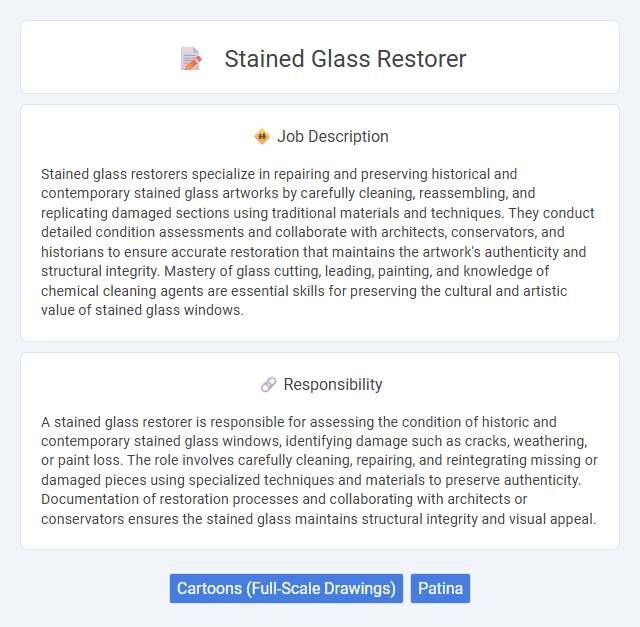
Stained glass restorers specialize in repairing and preserving historical and contemporary stained glass artworks by carefully cleaning, reassembling, and replicating damaged sections using traditional materials and techniques. They conduct detailed condition assessments and collaborate with architects, conservators, and historians to ensure accurate restoration that maintains the artwork's authenticity and structural integrity. Mastery of glass cutting, leading, painting, and knowledge of chemical cleaning agents are essential skills for preserving the cultural and artistic value of stained glass windows.
Individuals with strong attention to detail and patience are likely suitable for a stained glass restorer role, as the job requires precision and careful handling of delicate materials. Those who may struggle with fine motor skills or experience difficulty focusing for extended periods might find the position challenging. Physical stamina and good eyesight probably enhance job performance and overall suitability in this craft.
Qualification
A stained glass restorer typically requires a strong foundation in fine arts, art history, and specialized training in glass restoration techniques. Proficiency in working with various glass types, lead came, and traditional methods such as kiln firing and soldering is essential for preserving historical integrity. Certification from recognized conservation institutions and experience in delicate restoration projects enhance a candidate's qualifications significantly.
Responsibility
A stained glass restorer is responsible for assessing the condition of historic and contemporary stained glass windows, identifying damage such as cracks, weathering, or paint loss. The role involves carefully cleaning, repairing, and reintegrating missing or damaged pieces using specialized techniques and materials to preserve authenticity. Documentation of restoration processes and collaborating with architects or conservators ensures the stained glass maintains structural integrity and visual appeal.
Benefit
Stained glass restorers likely experience job satisfaction from preserving historical art, which can enhance cultural heritage and personal fulfillment. They probably benefit from opportunities to develop specialized skills in glasswork and conservation techniques, increasing their professional value. The role might also offer stable employment prospects within museums, churches, and restoration firms, contributing to career longevity.
Challenge
Stained glass restoration likely involves intricate challenges due to the delicate nature of antique glass and the need for precise color matching to maintain historical accuracy. Professionals probably encounter difficulties repairing cracked or missing pieces while preserving the original design and structural integrity. Success in this role depends on a restorer's ability to balance artistic skill with meticulous attention to detail under potentially fragile working conditions.
Career Advancement
Stained glass restorers enhance their skills through specialized training in conservation techniques and historical art methods, enabling career growth in museums, heritage sites, and private collections. Mastery of chemical treatments and lead came repair can lead to senior positions or consultancy roles in architectural preservation projects. Expertise in digital restoration tools and project management further expands opportunities for leadership within artisan workshops or cultural institutions.
Key Terms
Cartoons (Full-Scale Drawings)
Stained glass restorers rely heavily on Cartoons (full-scale drawings) as essential tools for accurately replicating original designs and repairing damaged sections of historical windows. These detailed, life-size sketches provide precise color, lead line, and compositional references, ensuring the restored glass matches the original artwork's integrity. Mastery in creating and interpreting Cartoons is critical for maintaining the authenticity and structural stability of stained glass restoration projects.
Patina
A stained glass restorer expertly enhances and preserves the patina of historic glass pieces, ensuring the original aged surface remains intact and visually authentic. Mastery in identifying and maintaining patina is crucial for conserving the glass's historical value and preventing over-cleaning or damage. Specialized techniques are employed to stabilize the patina while repairing cracks or missing segments, balancing restoration with preservation.
 kuljobs.com
kuljobs.com